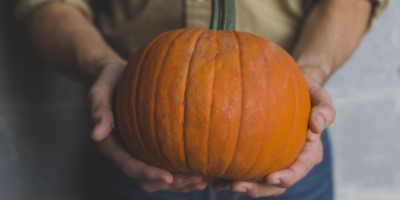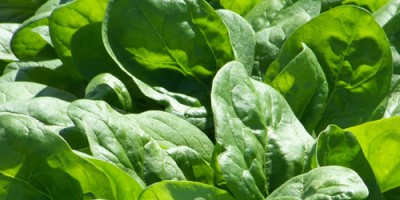Welcome to our Guide to Seasonal Eating: FALL Edition!
Seasonal eating is all about living in sync with the seasons. At Seasonal Roots, we’re also in sync with our community, from the local farmers and food artisans who make our food to the Seasonal Roots members who enjoy it.
We’re all connected through seasonal eating. So we have a (healthy) obsession with local produce, because it’s packed with flavor and nutrients — and easy to enjoy. That’s why our market is customizable and home delivered, Dirt to Doorstep, within days of harvest.
Now here’s the cherry on top:
Our guide to the fall produce that’s in season in Virginia and Maryland… and how to get the most out of it!
In this guide, you’ll find a little something for everyone. Because we’re a diverse bunch — chefs (official or not), foodies, newbies, vegetarians, meat lovers, you name it. So just click on the links below to jump straight to whatever interests you!
IN THIS ISSUE
- The BENEFITS & USES of Fall’s Produce Powerhouses (plus recipes & tips!)
- 3 More Reasons to Savor the LOCAL Flavors of Fall
- Here’s Why Our NUTRITION NEEDS CHANGE with the Seasons
- How to Take Advantage of HOME DELIVERY to Stay Healthy
BENEFITS & USES of Fall’s Produce Powerhouses
Below are some of the health benefits of seasonal eating. We’ve also selected a few of the Seasonal Roots team’s favorite recipes HERE.
As we get closer to Thanksgiving, we’ll be sharing some holiday feast tips. Oh, and be on the look-out for a little fact finding mission that will reveal which Thanksgiving dishes make the favorites list, coming soon…!
APPLES
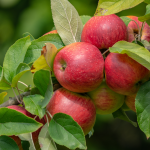
BENEFITS: Heart-healthy flavonoids in the skin, antioxidants, and 4 grams of dietary fiber.
USES: Eat raw as a stand-alone snack, in a smoothie or salad, in pork dishes, or cooked up as apple sauce or pie.
HARVEST: August-November
BEETS
BENEFITS: Red and gold beets are nutritional champs known for their high concentration of nitrates and accompanying blood pressure-lowering effects. They are also high in fiber and packed with nutrients.
USES: Beets are best enjoyed cooked and then can be used in salads, as a side, or even in a colorful dip.
HARVEST: year-round
BROCCOLI
BENEFITS: One cup of broccoli has as much vitamin C as an orange. Sulforaphane and other natural compounds in broccoli are reported to stop cancer cells from forming in your body.
USES: Enjoy broccoli raw, within a salad, with a dip, or mixed into a fantastic stir fry.
HARVEST: September-November
BRUSSELS SPROUTS

BENEFITS: Brussels sprouts are high in fiber, Vitamin K, Vitamin C, plus folate and iron.
USES: Serve as a side or atop salads and meats, steam or roast, serve with salt or add tangy or savory sauces like balsamic vinegar.
HARVEST: September-March
CARROTS
BENEFITS: Loose carrots are a particularly good source of beta carotene, fiber, vitamin K1, potassium, and antioxidants.
USES: Raw with dips or in salad, roasted as a side, or that perennial favorite — carrot cake!
HARVEST: September–November
CAULIFLOWER
BENEFITS: Vitamin C and compounds that may help to prevent cancer and lower cholesterol.
USES: Raw with dips or in salad, steamed or roasted as a side, blended like mashed potatoes or pureed into soup.
HARVEST: September–June
CELERY ROOT (a.k.a.Celeriac)
BENEFITS: High in fiber and a good source of vitamins B6, C, K and minerals phosphorus, potassium, and manganese.
USES: Raw or cooked, celery root is a versatile vegetable. It can be used as a base for salads, stews and soups and also works well mashed, baked, roasted or boiled.
HARVEST: September–November
CELERY
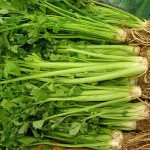
BENEFITS: Packed with antioxidants, vitamin C, beta carotene, and flavonoids, and a great source of phytonutrients which have been shown to reduce inflammation.
USES: Celery is great raw and you can eat the leaves too! It’s a classic base ingredient in soups and stews, or try it steamed or baked for a twist on this good old reliable veg.
HARVEST: October-December
DARK LEAFY GREENS
BENEFITS: Iron, calcium, vitamins A and C, and fiber.
USES: Raw in a salad or smoothies, or baked into other dishes. Cooking makes it easier for our bodies to digest its nutrients.
HARVEST: Year-round
FENNEL
BENEFITS: Vitamin C, potassium.
USES: Looks like the love child between a dill plant and an onion but has a mild licorice flavor – add to soups, sides, and mains.
HARVEST: Fall through spring
PARSNIPS
BENEFITS: Potassium, fiber.
USES: Sweeter and nuttier than carrots, roast alone or with just about every other fall vegetable.
HARVEST: October-April
PEARS
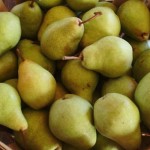
BENEFITS: Vitamin C, copper, 4 grams of fiber.
USES: Enjoy raw alone or with cheese, in salads, and baked or poached desserts.
HARVEST: August-February
PUMPKINS
BENEFITS: Potassium, tons of fiber, B vitamins.
USES: Pies, soups, and sides, plus toss seeds in olive oil and salt, then roast for an addictive snack or salad topping. Also jack o’lanterns!
HARVEST: October-February
RUTABAGAS
BENEFITS: Vitamin C, fiber.
USES: Like a cross between a turnip and a parsnip, they’re delish in casseroles, puree with turnips and carrots for soup, or roasted with ginger, honey, or lemon.
HARVEST: October-April
SPINACH
BENEFITS: Vitamins A, C, K, iron, and disease-fighting phytonutrients.
USES: Raw in a salad or smoothies, steamed as a stand-alone or baked into other dishes. Cooking makes it easier for our bodies to digest its nutrients.
HARVEST: Year-round, but it gets sweeter after the first nip from Jack Frost
SWEET POTATOES
BENEFITS: Vitamin A, iron, and anti-inflammatory properties.
USES: Roast like a potato or cut up like fries, add to salads and stews, puree into soups.
HARVEST: September–December
TURNIPS
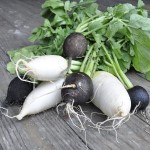
BENEFITS: Vitamin C (roots), vitamins A, K, and folate (leaves).
USES: Steam, roast, or boil the roots, flavor with fennel, bread crumbs, or brown sugar, adds a slightly bitter complement to sweet parsnips, carrots, or mashed potatoes. Steam or stir fry the leaves.
HARVEST: September–April
WINTER SQUASHES
BENEFITS: Omega-3 fatty acids, vitamin A.
USES: Butternut and acorn have thick skin and can be stored for months. Bake, steam, or roast plain or with cinnamon and ginger, add to salads and stews, puree into soups.
HARVEST: October–February
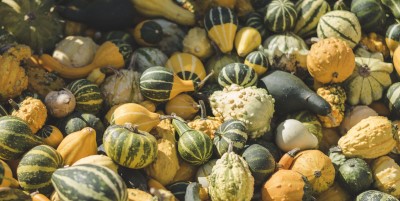
3 More Reasons to Savor the LOCAL Flavors of Fall
Seasonal eating is good for you and the planet:
- RIPENESS & A LOWER CARBON FOOTPRINT! Fruits and veggies absorb flavor and nutrients (like vitamins, minerals, and antioxidants) from the sun and earth – right up until the moment they’re harvested. When they’re picked early to ship long distances, they never reach their full potential… even if they eventually look ripe. This is the reality of our industrial food system and it leaves many fruits and vegetables lacking in taste and nutrition.
- REAL FOOD MATTERS! Eating local ensures that you are eating real food with real nutrients. Local food is packed with antioxidants which may help prevent or delay cell damage. When you get your antioxidants from food, studies have found it can improve cognitive function and help prevent cancer, heart disease, and other illnesses! Antioxidant supplements have not been proven to do those things. And of course fresh local produce retains its flavor, unlike those poor road weary veggies traveling from across the country and beyond.
- KNOWING WHERE YOUR FOOD COMES FROM DELIVERS PEACE OF MIND. We partner with local farmers we know, and in our market we list who produced what. Many of our farms are multi-generational, caring for their land, crops, and animals with the next generation in mind. They use sustainable practices, what we call old-school organic, like rotating their crops to avoid sucking all the nutrients out of the soil.
Here’s Why Our NUTRITION NEEDS CHANGE with the Seasons
Seasonal eating means eating what grows naturally in each season – which is what our bodies are designed to do.
For instance, now that it’s FALL, the apple harvest is starting. Like a lot of other fall produce, apples are high in fiber and pectin that help cleanse the intestines and digest fats. And that helps us get ready for cold weather.
Because when WINTER closes in, our bodies need more fats and protein from meats, fish, nuts, seeds, legumes, root vegetables, and winter squashes. Winter’s cold, dry weather can dry us out. But foods that are rich in protein and fat restore moisture to our bodies and make us less susceptible to colds and flu.
After processing all those fats and heavier foods all winter, we really need to detoxify! So in the SPRING, Mother Nature provides bitter greens like arugula to help clean out our livers.
By the time SUMMER heats up, we’re spending more time outside. We’re more active, so we need the extra energy we get from carbohydrates and sugars. Naturally, warm weather fruits like peaches and strawberries serve up plenty of both. Plus, produce like cucumbers and watermelon help us hydrate, too.
If you’re practicing seasonal eating, you’re getting what your body needs. Meanwhile, the blossoms on those apple trees are ripening into fruit again…
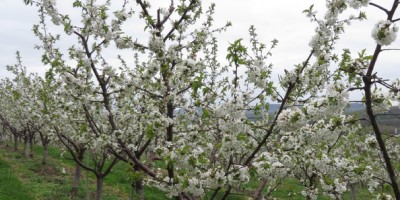

How to Take Advantage of HOME DELIVERY to Stay Healthy
Home delivery is more than just a convenient way to enjoy seasonal eating. It can make a difference to your health.
As we head into cold and flu season, plus an ongoing pandemic, one of the simplest ways to stay healthy is to avoid exposure. The more you can steer clear of germ-filled public places, the fewer chances you have of catching something.
To reduce your exposure at the grocery store, customize your Seasonal Roots order with essential extras like local eggs, milk, baked goods, salsas, plant protein, meats, artisan goods, and more. Save your grocery store trips for stocking up on non-perishables. Fewer trips equal less exposure.
Our members tell us there’s also another healthy benefit of home delivery: It makes it easy to keep fresh, good-for-you food on hand. That includes more fruits and veggies in greater variety and healthier snacks. It’s much harder to avoid temptation in the grocery store aisle.
So let your neighborhood Market Manager take really good care of you and put home delivery to work for you this fall!
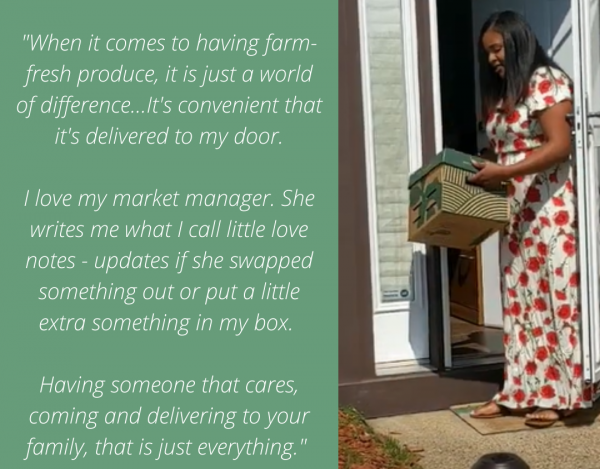
— Erica, Seasonal Roots member since 2016
About Seasonal Roots
Since 2011, Seasonal Roots’ online farmers market has connected Virginia families with local family farmers who use sustainable, humane practices. Our neighborhood market managers – who believe in living better through scrumptious, healthy eating, being kind to animals, protecting the environment, and spreading joy – home-deliver freshly harvested produce, pastured eggs, grass fed dairy and meat, plus artisan fare. We empower our members to eat better and live better with more nutritious, flavorful food that’s good for us and good for the planet. More info at seasonalroots.com.
